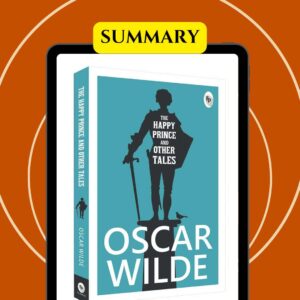The Happy Prince Summary
The Happy Prince by Oscar Wilde is a poignant fairy tale that delves into themes of selflessness, sacrifice, and kindness. In this detailed summary, we will explore the narrative, characters, themes, and symbolism present in the story, shedding light on its enduring appeal and cultural significance.
- The summary of The Happy Prince is crucial for readers to grasp the depth and beauty of Wilde’s storytelling.
- The main themes conveyed in the story, such as selflessness and sacrifice, resonate with audiences of all ages.

Table of Contents
Background of Oscar Wilde and The Happy Prince
Renowned for his wit and literary prowess, Oscar Wilde was a prominent figure in the late 19th-century literary scene. Born in Dublin in 1854, Wilde enriched the world of literature with his plays, essays, and fairy tales, including The Happy Prince.
- The Happy Prince was inspired by Wilde’s own experiences and his observations of social inequalities.
- The tale was first published in 1888 and marked a significant milestone in Wilde’s literary career.
Characters in The Happy Prince
The characters in The Happy Prince add depth to the narrative and play pivotal roles in conveying the story’s moral lessons.
The Happy Prince
- The Happy Prince symbolizes selflessness and compassion, as he sacrifices his own happiness to alleviate the suffering of the city’s residents.
- Through the Prince’s actions, Wilde highlights the importance of helping those in need and the true meaning of wealth.
The Swallow
- The Swallow serves as the Prince’s faithful companion and undergoes a transformation through their interactions.
- The Swallow’s journey with the Prince showcases the power of empathy and the rewards of selfless acts.
Other Minor Characters
- Various minor characters, such as the Mayor and the Matchgirl, contribute to the narrative’s themes of kindness and social responsibility.
- Their interactions with the Prince and the Swallow underscore the interconnectedness of individuals in society.
Plot Summary of The Happy Prince
The plot of The Happy Prince unfolds in a city where a gilded statue of a Prince watches over its inhabitants, aided by a devoted Swallow.
- The city’s residents are unaware of the Prince’s suffering, as he uses his precious gems and gold leaves to help the poor and needy.
- The Swallow, moved by the Prince’s generosity, decides to stay and assist him in his charitable endeavors.
- As winter approaches, the Swallow faces a difficult decision that leads to a bittersweet conclusion for both the Prince and the bird.
- Through the Prince’s ultimate sacrifice and the Swallow’s unwavering loyalty, Wilde delivers a powerful message on the value of compassion and altruism.
Themes and Symbolism in The Happy Prince
The themes and symbolism in The Happy Prince enrich the narrative by adding layers of meaning and depth to the story.
Themes
- Selflessness: The Prince’s acts of selflessness underscore the importance of putting others’ needs before one’s own.
- Sacrifice: Both the Prince and the Swallow make sacrifices that highlight the transformative power of empathy and altruism.
- Kindness: The story emphasizes the impact of simple acts of kindness on individuals and communities.
Symbolism
- The Happy Prince statue represents generosity and compassion, while the Swallow embodies loyalty and empathy.
- The precious gems and gold leaves symbolize the true richness of giving and the rewards of selfless deeds.
- Wilde’s use of allegory and symbolic elements enhances the story’s impact and allows readers to reflect on its moral lessons.
Critical Reception of The Happy Prince
The Happy Prince has garnered praise from critics and audiences alike for its timeless themes and compelling storytelling.
- Critics have lauded the story’s moral depth and emotional resonance, cementing its status as a classic in the literary canon.
- The enduring popularity of The Happy Prince reflects Wilde’s ability to craft narratives that inspire reflection and empathy in readers.
- The story’s continued relevance in contemporary society speaks to its universal message of compassion and selflessness.
Comparison with Other Works by Oscar Wilde
Contrasting The Happy Prince with Wilde’s Other Works
- The Happy Prince is a poignant fairy tale by Oscar Wilde that diverges from his usual comedic plays and witty prose.
- Unlike his renowned works like The Importance of Being Earnest or An Ideal Husband, this story delves into themes of selflessness and sacrifice.
Similarities in Themes and Writing Style
- Both The Happy Prince and Wilde’s other works share a common thread of social criticism and moral introspection.
- The satirical tone present in many of Wilde’s works is also subtly woven into the allegorical narrative of The Happy Prince.
Reflection on the Uniqueness of The Happy Prince in Wilde’s Oeuvre
- Despite Wilde’s versatility in different literary genres, The Happy Prince stands out as a timeless enchanting piece that showcases a different facet of his storytelling prowess.
- The depth of emotion and moral depth found in The Happy Prince sets it apart from his more flamboyant and comedic works, demonstrating Wilde’s range as a writer.
Adaptations and Interpretations of The Happy Prince
Overview of Film, Theater, and Musical Adaptations
- Various adaptations of The Happy Prince have been brought to life on different artistic platforms, including film, theater, and musical performances.
- Notable adaptations include the animated film directed by Hugh Dibbens and the theatrical production staged in renowned theaters across the world.
Analysis of Interpretations by Different Adaptations
- Each adaptation of The Happy Prince brings a unique perspective to the story, emphasizing different aspects of its themes and characters.
- Through visual and auditory mediums, adaptations offer varying interpretations of the selflessness, sacrifice, and kindness depicted in the original tale.
Discussion of Impact of Modern Retellings on the Original Story’s Legacy
- Modern retellings of The Happy Prince serve to keep the essence of Wilde’s story alive for contemporary audiences.
- The reinterpretation of the narrative through diverse creative mediums ensures that the themes and messages of the original story remain relevant and impactful in today’s context.
Lessons Learned from The Happy Prince
Reflection on Moral and Ethical Lessons
- The story of The Happy Prince prompts readers to reflect on the virtues of selflessness, sacrifice, and kindness, portraying these qualities as essential for a meaningful existence.
- Through the characters of the Prince and the Swallow, Wilde imparts valuable lessons on empathy, benevolence, and the importance of giving without expecting anything in return.
Application of The Happy Prince‘s Messages to Contemporary Society
- The timeless themes of The Happy Prince continue to resonate in a modern society fraught with materialism and individualism, serving as a reminder of the enduring value of compassion and altruism.
- By examining the narrative through a contemporary lens, readers can draw parallels between the characters’ actions in the story and real-world instances of generosity and humanity.
Personal Insights and Takeaways for Readers
- Readers of The Happy Prince are encouraged to imbibe the spirit of selflessness and altruism portrayed in the narrative, fostering a greater sense of empathy and social responsibility.
- The emotional impact of the story lingers, prompting introspection and inspiring individuals to strive towards embodying the noble virtues exemplified by the characters in Wilde’s enchanting tale.
Frequently Asked Questions (FAQs)
What is the message of The Happy Prince by Oscar Wilde?
The Happy Prince conveys themes of selflessness, sacrifice, and kindness. It emphasizes the importance of compassion and helping others in need.
Who are the main characters in The Happy Prince?
The primary characters in The Happy Prince are the Happy Prince statue and the Swallow. Other minor characters include the Mayor, the Seamstress, and the Matchgirl.
How does The Happy Prince story end?
The story concludes with the Swallow dying due to the harsh winter, having stayed to help the Prince until the end. The leaden heart of the Happy Prince is also taken to heaven, leaving the town with only the broken leaden body.
What is the setting of The Happy Prince?
The Happy Prince is set in a city where a beautiful statue of a Prince stands high above the citizens. The story unfolds against the backdrop of poverty and suffering in the city.
What are some of the key themes in The Happy Prince?
Some key themes in The Happy Prince include selflessness, sacrifice, compassion, friendship, and the contrast between wealth and poverty.
Conclusion:
In conclusion, The Happy Prince by Oscar Wilde remains a timeless and thought-provoking story that resonates with readers of all ages. Through its poignant themes and memorable characters, the tale continues to inspire reflection on the values of kindness, generosity, and empathy. Whether revisiting the original text or exploring its various adaptations, The Happy Prince serves as a reminder of the enduring power of storytelling to impart meaningful lessons and spark discussions on morality and social responsibility. Its legacy stands as a testament to Wilde’s skill as a writer and his ability to capture the essence of humanity in a beautifully crafted narrative.





